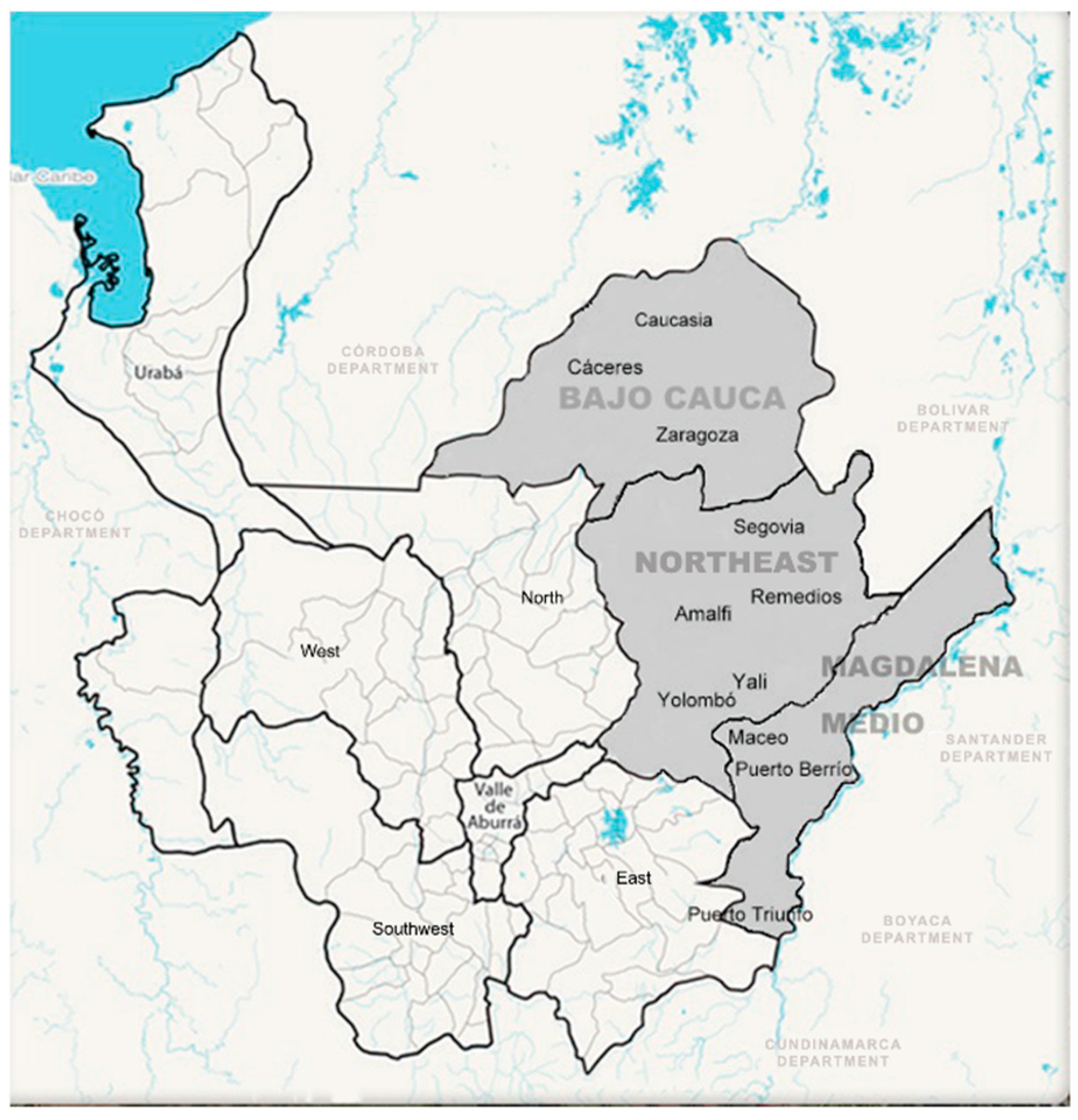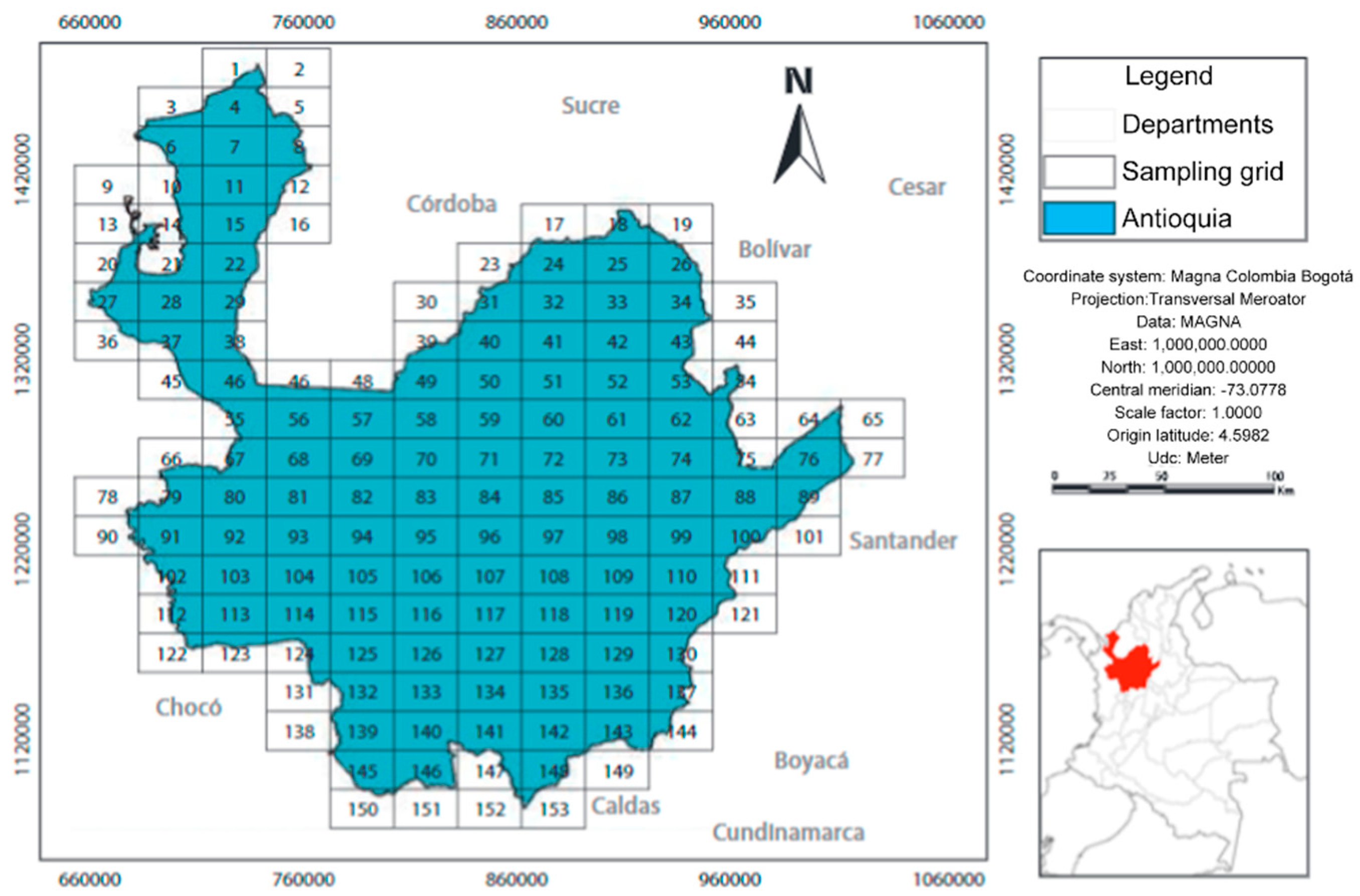Sustainability of the Artisanal and Small-Scale Gold Mining in Northeast Antioquia-Colombia
Abstract
1. Introduction
2. Methodology
3. Theoretical Framework
3.1. Artisanal and Small-Scale Gold Mining in Northeast Antioquia
- Very high: This range occurs when twenty parts of mercury are used for each part of extracted gold [23].
- Extreme: This range occurs when up to fifty parts of mercury are used for each part of recovered gold, which makes up a ratio of 50:1 [23].
3.2. Concepts of Sustainability
- Nature should not be exposed to systematic increases in the concentration of substances in the earth’s crust. For example, rivers should not be exposed to systematic increases in mercury concentration.
- Nature should not be exposed to systematic increases in the concentration of substances produced by society. This means, for example, that society can produce in a more efficient way to reduce waste.
- Nature should not be exposed to systematic increases in physical degradation. This means the efficient management of resources and land, which should always be managed with caution regarding making modifications to nature.
- There should be no structural barriers that affect people’s health, influence, competence, or impartiality. This means that products and services must be offered, and different business models and practices must be implemented to ensure that human rights are fulfilled and that communities have living conditions that allow them to satisfy their needs.
3.3. Sustainability and Mining
- Facilitating the creation of mineral wealth: As mineral deposits do not form in short periods, it is first necessary to develop knowledge and study of the occurrence (or probability of occurrence). This is practiced to create mineral wealth that contributes to sustainability [26].
- Ensuring that mineral development is socially and economically efficient: This principle focuses on the maximization of benefits from economic efficiency, that is, a mining project must be very clear about its expenses, incomes, and indirect benefits at the time of assessing sustainability [26]. Indirect benefits are those that would not occur without the presence of the project in the community, such as local purchases (like protection elements, fuel, food, etc.) or contributions to increase health quality and infrastructure. However, these indirect benefits can also have consequences such as increases in alcoholism, prostitution, environmental damage, among others. Therefore, this principle considers that the project should compensate, for these negative consequences, called indirect costs in the same way [26].
- Distributing surpluses from mining development fairly: Most of the time, mining projects generate surpluses, even after compensating for indirect costs [26]. However, there is an unknown as to how these are distributed fairly, whereupon Eggert mentions three different currents of thought about what is fair. The first, which is Aristotelian, emphasizes proportional distribution; however, this may mean that the profits are distributed among the partners in proportion to their contribution to the surplus. The second current of thought is based on the author Jeremy Bentham [26], who argues that the surplus must be distributed in a way that contributes to the greater good; however, who determines what is the greater good? The company through reinvestment in mineral development? The State through the construction of schools? The third current, which is proposed by John Rawls [26], maintains that this surplus should be destined to contribute to the least benefited groups of society. In this sense, for mining, this approach represents the investment of surpluses in activities that help reduce poverty [26].
- Sustaining the benefits of mining, even after its closure and abandonment: Even though it was mentioned that from Eggert’s perspective, sustainability in mining does not consist of indefinitely sustaining a community; the benefits of the operation can be extended permanently [26]. This principle is fundamental for the contribution of sustainability. Thus, its main idea lies in the fact that the company should save and invest part of its income and then periodically reinvest the profits from that investment to sustain spending indefinitely [26].
4. Results
4.1. Environmental Sustainability
4.2. Economic Sustainability
4.3. Sociocultural Sustainability
- The first of the difficulties lies in how to identify and evaluate these costs, benefits, and risks, considering the cultural, economic, and environmental attributes [24].
- The second is more focused on the culture, policies, and laws of companies―which may well be an artisanal gold mining project―which on many occasions, hinder the transparency with which this issue is addressed [24].
5. Conclusions
Author Contributions
Funding
Institutional Review Board Statement
Informed Consent Statement
Data Availability Statement
Conflicts of Interest
References
- López, I. Sobre el desarrollo sostenible y la sostenibilidad: Conceptualización y crítica. Rev. Castell. Manch. Cienc. Soc. 2015, 20, 111–128. [Google Scholar] [CrossRef]
- Giovannoni, E.; Fabietti, G. What is Sustainability? A Review of the Concept and Its Applications. In Integrated Reporting: Concepts and Cases That Redefine Corporate Accountability; Busco, C., Frigo, M., Riccaboni, A., Quattrone, P., Eds.; Springer International Publishing: Manhattan, NY, USA, 2013; pp. 21–40. [Google Scholar]
- Trefny Center. Mercury and Gold-Amy Martin-EDS. [Video]. Vimeo. Available online: https://vimeo.com/298472887/ea1d73d5e0 (accessed on 1 November 2018).
- Telmer, K.; Veiga, M. World Emissions of Mercury from Artisanal and Small-Scale Gold Mining. In Mercury Fate and Transport in the Global Atmosphere; Pirrone, N., Robert, M., Eds.; Springer: Berlin/Heidelberg, Germany, 2009; pp. 131–172. Available online: https://link.springer.com/content/pdf/bfm%3A978-0-387-93958-2%2F1.pdf (accessed on 1 September 2020).
- Galvis, S.R. El mercurio en la minería ilegal de oro en los países del Bioma Amazónico: Diagnóstico de flujos comerciales, información científica y respuestas institucionales. Fundación Gaia Amazonas y Red Amazónica de Información Socioambiental Georreferenciada-RAISG. 2018. Available online: https://www.gaiaamazonas.org/uploads/uploads/books/pdf/Informe_Hg_FGA_RAISG_-_con_mapas.pdf (accessed on 1 September 2020).
- Pantoja, F.H.; y Pantoja, S.D. Problemas y desafíos de la minería de oro artesanal y en pequeña escala en Colombia. Rev. Fac. Cienc. Econ. 2016, 24, 147–160. [Google Scholar] [CrossRef]
- Unidad de Planeación Minero Energética—UPME. Oro; 2020. Available online: https://www1.upme.gov.co/simco/Cifras-Sectoriales/Paginas/oro.aspx (accessed on 1 September 2020).
- Perea, C.; y Restrepo, O. Incorporación de Tecnologías Limpias En Unidades Mineras Ubicadas En El Departamento de Antioquia. In Proceedings of the XIV Congreso Internacional de Ingeniería Metalúrgica, Materiales y Medio Ambiente CONIMETM, Huacho, Peru, November 2015. [Google Scholar] [CrossRef]
- Bernal-Guzmán, L.J. Minería de oro en el Nordeste antioqueño: Una disputa territorial por el desarrollo. Gestión Ambiente 2018, 21, 74–85. [Google Scholar] [CrossRef]
- García, O.; y Molina, J. Introducción de tecnologías más limpias en la minería y la extracción del oro artesanales, en el nordeste Antioqueño y Bajo Cauca Antioqueño, Colombia. 2011, Volume 51. Available online: https://www.yumpu.com/es/document/read/14509279/introduccion-de-tecnologias-mas-limpias-en-la-mineria (accessed on 1 August 2020).
- Unidad de Planeación Minero Energética—UPME. Plan Nacional de Desarrollo: Minería responsable con el territorio; Ministerio de Minas y Energía: Bogotá, Colombia, 2017.
- De Haan, J.; Dales, K.; Mcquilken, J. Mapping Artisanal and Small-Scale Mining to the Sustainable Goals; University of Delaware: Newark, DE, USA, 2020. [Google Scholar]
- Hernández, R.; Fernández, C.; y Baptista, M. Metodología De La Investigación, 6th ed.; McGraw-Hill: New York, NY, USA, 2010. [Google Scholar]
- Sandoval, C. Investigación Cualitativa; ARFO Editores e Impresores Ltda: Bogotá, Colombia, 2002. [Google Scholar]
- Aramburo, C.; Contreras, A.; Giraldo, C.; Hinestroza, P. Nordeste. Desarrollo Regional: Una Tarea Común Universidad-Región; Universidad de Antioquia: Medellín, Colombia, 2007; Available online: http://bibliotecadigital.udea.edu.co/bitstream/10495/10010/1/UniversidadDeAntioquia_2007_NordesteDesarrolloRegional.pdf (accessed on 1 June 2020).
- Cahucopana. Una Mirada Sobre el Nordeste Antioqueño. 2013. Available online: https://prensarural.org/spip/spip.php?article11781#:~:text=Limita%20al%20occidente%20con%20la,bajo%2C%20medio%20y%20alto%20nordeste (accessed on 1 June 2020).
- Veiga, M. Antioquia, Colombia: The World’s Most Polluted Place by Mercury: Impressions from Two Field Trips; University of British Columbia: Vancouver, BC, Canada, 2010; Available online: http://redjusticiaambientalcolombia.files.wordpress.com/2011/05/final_revised_feb_2010_veiga_antioquia_field_trip_report.pdf (accessed on 1 June 2020).
- García, O.; Veiga, M.; Cordy, P.; Suescún, O.; Molina, J.; Roeser, M. Artisanal gold mining in Antioquia, Colombia: A successful case of mercury reduction. J. Clean. Prod. 2015, 90, 244–252. [Google Scholar] [CrossRef]
- Richard, M.; Moher, P.; Rossin, R.; Telmer, K. Using Retorts to Reduce Mercury Use, Emissions, and Exposures in Artisanal and Small-Scale Gold Mining: A Practical Guide; Artisanal Gold Council: Victoria, BC, Canada, 2017; Available online: http://www.artisanalgold.org/wordpress/wp-content/uploads/2017/01/Retort_guide_Oct2014_lowQ_version1.0_Eng.pdf (accessed on 1 September 2020).
- Sánchez, L.; Molina, J.; y Machado, R. Línea base del mercurio, departamento de Antioquia: Sedimentos activos finos de corriente escala 1:500.000. Rev. Ing. Univ. Medellín 2019, 18, 13–23. [Google Scholar] [CrossRef]
- Molina, C.; Arango, C.; y Sepúlveda, H. Contaminación por mercurio de leche materna de madres lactantes de municipios de Antioquia con explotación minera de oro. Biomédica 2018, 38, 19–29. [Google Scholar] [CrossRef] [PubMed]
- Yannopoulos, J. The Extractive Metallurgy of Gold; Van Nostrand Reinhold: New York, NY, USA, 1990. [Google Scholar]
- United Nations Environment Program—UNEP. Reducing Mercury Use in Artisanal and Small-Scale Gold Mining; UNEP: Nairobi, Kenya, 2012; Available online: https://www.unido.org/sites/default/files/files/2017-11/ASGM_English%20%281%29.pdf (accessed on 1 September 2020).
- MMSD. Seven Questions to Sustainability: How to Assess the Contribution of Mining and Minerals Activities; International Institute for Sustainable Development: Winnipeg, MB, Canada, 2002; Available online: https://www.iisd.org/system/files/publications/mmsd_sevenquestions.pdf (accessed on 1 August 2020).
- Porritt, J. Capitalism as If the World Matters; Earthscan: London, UK, 2007. [Google Scholar]
- Eggert, R. What Sustainability and Sustainable Development Mean for Mining. In Sustainable Management of Mining Operations; Botin, J.A., Ed.; Society for Mining: Englewood, CO, USA, 2020; pp. 19–32. Available online: https://drive.google.com/file/d/1cCcPz1-pId-gFj8SnqXfddnU4bG31gtL/view (accessed on 1 August 2020).
- Nathan, J. Is The Natural Step’s Theory about Sustainability Still Sustainable? A Theoretical Review and Critique. J. Sustain. Dev. 2018, 11, 1913–9063. [Google Scholar] [CrossRef]



| Municipality | Remedios | Segovia |
|---|---|---|
| Underground exploitations | 109 | 146 |
| Workers, mines and partners | 2150 | 4000 |
| Entables or artisan plants | 22 | 75 |
| Amalgamating mills | 1874 | 526 |
| Entable workers | 38 | 362 |
| Percentile [%] | Concentration [μg kg −1] |
|---|---|
| 5 | 3.4 |
| 25 | 48 |
| 50 | 67 |
| 75 | 98 |
| 90 | 182 |
| 98 | 860 |
Publisher’s Note: MDPI stays neutral with regard to jurisdictional claims in published maps and institutional affiliations. |
© 2021 by the authors. Licensee MDPI, Basel, Switzerland. This article is an open access article distributed under the terms and conditions of the Creative Commons Attribution (CC BY) license (https://creativecommons.org/licenses/by/4.0/).
Share and Cite
Baena, Ó.J.R.; Mendoza, L.E.M. Sustainability of the Artisanal and Small-Scale Gold Mining in Northeast Antioquia-Colombia. Sustainability 2021, 13, 9345. https://doi.org/10.3390/su13169345
Baena ÓJR, Mendoza LEM. Sustainability of the Artisanal and Small-Scale Gold Mining in Northeast Antioquia-Colombia. Sustainability. 2021; 13(16):9345. https://doi.org/10.3390/su13169345
Chicago/Turabian StyleBaena, Óscar Jaime Restrepo, and Luis Enrique Martínez Mendoza. 2021. "Sustainability of the Artisanal and Small-Scale Gold Mining in Northeast Antioquia-Colombia" Sustainability 13, no. 16: 9345. https://doi.org/10.3390/su13169345
APA StyleBaena, Ó. J. R., & Mendoza, L. E. M. (2021). Sustainability of the Artisanal and Small-Scale Gold Mining in Northeast Antioquia-Colombia. Sustainability, 13(16), 9345. https://doi.org/10.3390/su13169345







